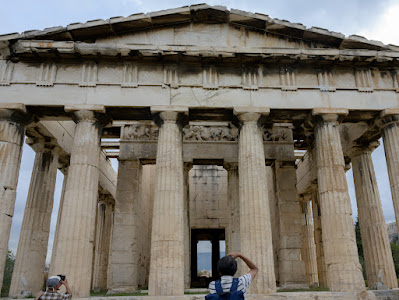California 30th October, a town called Bodie
We rattled our way into Bodie and stopped in the parking area - you have to buy a ticket. We lost ours after moving to the picnic area for lunch and got a notice of a fine from the ranger. We scrabbled on the floor, found the original ticket and then hunted down a ranger who tore up his paperwork. The ranger service is a force to be reckoned with. They have the same status as policemen and can carry firearms. Not like your run of the mill National Trust wardens.
Bodie was and still is a god forsaken place. Above the tree line it is barren and cold at over 8,000ft, where winds over the scrubby hills can reach 100mph.
Bodie was and still is a god forsaken place. Above the tree line it is barren and cold at over 8,000ft, where winds over the scrubby hills can reach 100mph.
William Bodey came to this wilderness area and found gold in1859. He died a year later, caught in a blizzard en route for supplies and never saw the town which a year later had a populations of 5,000- 7,000 people and within 20 years had grown to 10,000 inhabitants and acquired a reputation for wickedness, drunkenness and 'the worst climate out of doors'. Killings, robberies and street fights occurred regularly and the fire station bell, which rang the number of years of age of the deceased when they were buried, had scarcely a silent day. There were 65 taverns and a number of houses of ill repute. The population had shrunk to 3,000 by 1882 when a number of smaller mines closed. Following 2 disastrous fires the number of people fell further to 698 people by 1910 and by 1920 to 120. Another fire occurred in 1932 and in 1941 the last gold mine closed. In spite of this a few hardy citizens clung on until, to stop vandalism, the Bodie State Park was formed in 1962 and the remaining inhabitants were moved out. Only about 5% of the original housing stock remains and these have been kept in a state of 'arrested decay'. The contents of the houses have been left as if abandoned by their owners, and can be seen murkily through the window panes, untouched on the inside as dust accumulates. I am sure some of the things were originally planted or arranged but they are now all quietly rotting. There is a legend that if anything is taken from Bodie, even a stone, you will have bad luck. This may have been propagated by the rangers in order to safeguard the town.
We left the car park and the first thing we saw was some machinery which stands alongside the road. Rather than take the prescribed route, which would have been sensible we cut across off the beaten track past some small hovels situated in the 'Chinese' quarter. By 1882 a railroad had been built between Bodie and Mono Lake Mills in order to provide wood for the mines and most of the labour for this had been provided by a cheap Chinese work force. This was a reason for discontent for redundant miners which added to the prejudice against local the Chinese population. The Chinese quarter housed several hundred people along with opium dens, laundries and even a Taoist temple, but has largely disappeared.
You can see in the picture below how much detritus is present on the ground and then three pictures of the machinery including a wooden head frame and steam hoist.
We did not get hold of a map of Bodie until the visitor centre opened later and so the house names that I have put below were discovered through looking at pictures on the internet and conjecture on our route. The state of the buildings ranges from reasonable to just about to totter over.
The now peeling wall paper was applied over layers of newspaper to serve as insulation to try and keep drafts out of these insubstantial buildings. Winters at Bodie were not to be underestimated and the snow would lie several feet deep.
 |
| The Seiler House
Seiler owned a saloon in the town.
|
Discarded tin from kerosene cans was used for roofing and repair work on buildings. You can see it on the roof of the outhouse below.
 |
| His and hers loo in the grounds of Kirkwood House
Kirkwood owned a livery stables in the town, very important in a town of this size
|
Below is the Conway House which we passed on our way to the Standard Mine. The Conways' ran freight wagons between Bodie and carson City in the 1880's. They hung on in this house Bob Conway being one of the few residents left in the town after the outbreak of World War 2.





































Comments
Post a Comment